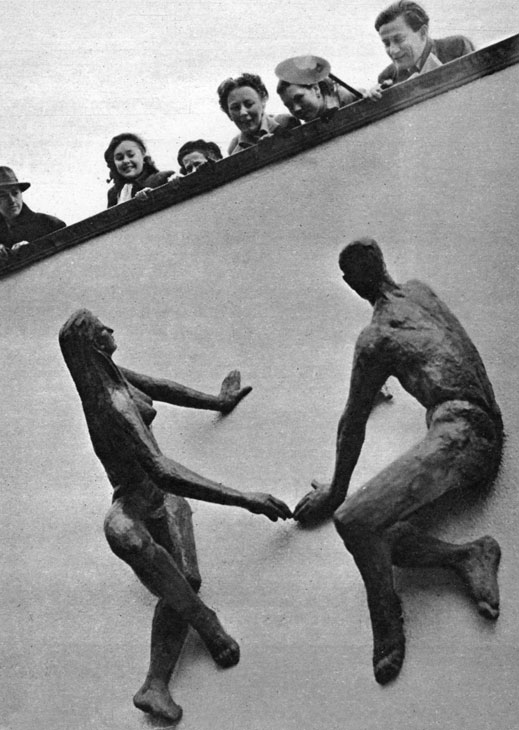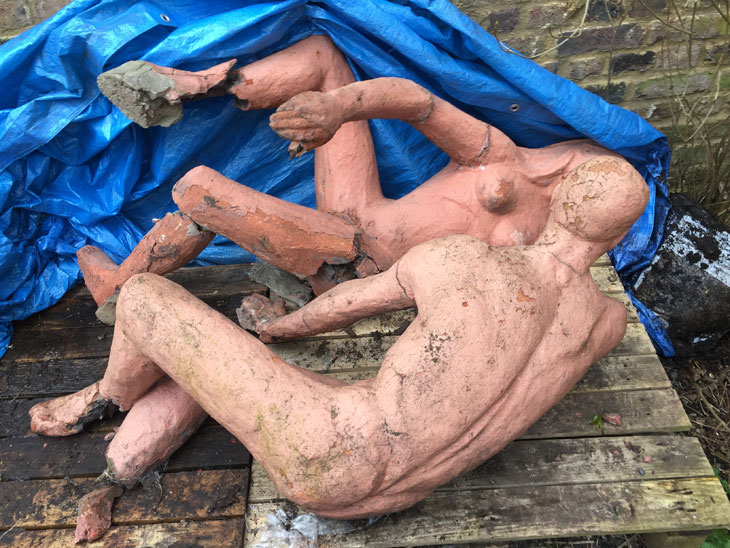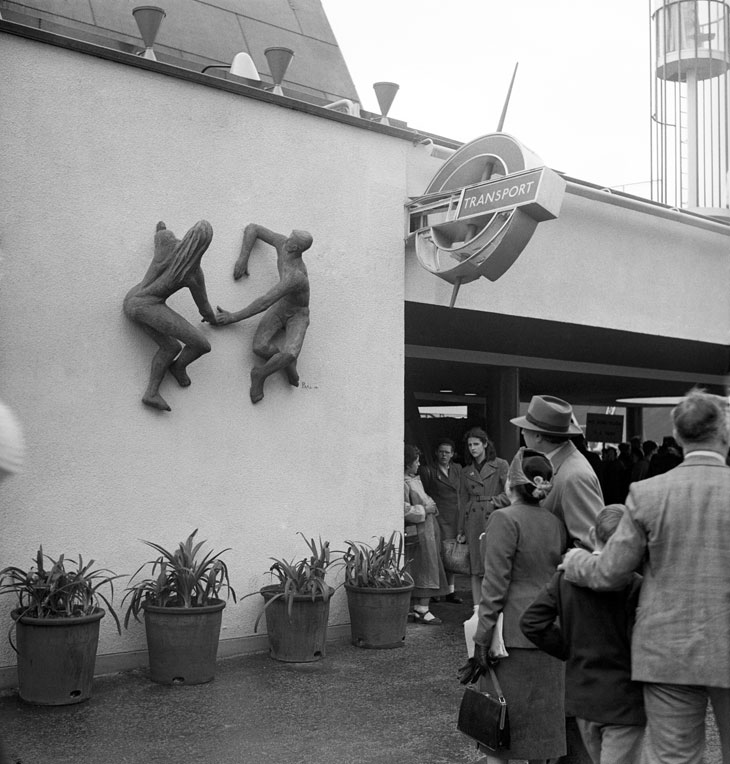The discovery last month of Peter Laszlo Peri’s The Sunbathers, battered and forgotten beneath a shroud of plastic sheeting, seemed laden with symbolism. Emerging into a freakish but fittingly sunny April, the concrete figures – made from what in 1951 was a cutting-edge material – hailed from a very different place, an Adam and Eve for the new and better Britain so optimistically envisaged in the years following the end of the Second World War.

Photograph in The Illustrated London News, Festival of Britain supplement, (12 May 1951). © Illustrated London News Ltd/Mary Evans
Historic England’s campaign to recover lost public artworks commissioned during the post-war period has undoubtedly benefitted from an atmosphere of generalised nostalgia for the 1950s. Launched in 2015 and bolstered by an exhibition the following year, the campaign also tapped into what – if viewing figures for the BBC’s Fake or Fortune? indicate anything – is a national obsession with sleeper-hunting. But while sleepers (works whose true value has been overlooked) offer self-styled art detectives the thrill of uncovering lost or misattributed works by famous artists, many of the lost sculptures, The Sunbathers included, are by artists who are all but forgotten.
It ought to be difficult for figures well-regarded and successful in their own lifetimes to fade into obscurity, but several recent exhibitions have shown just how readily artists fall through the cracks of history. The reputation of English court portraitist Cornelius Johnson was most cruelly eclipsed by the arrival of Van Dyck, while Giovanni Battista Moroni, one of the most celebrated portraitists of the 16th century, was dealt a crucial blow when Vasari neglected to visit Bergamo on his 1566 tour of northern Italy. In the 20th century Winifred Knights found her reputation dwindling as her health failed, and by the time of her death in 1947 she was almost unknown.

Peter Laszlo Peri’s The Sunbathers, rediscovered at the Clarendon Hotel, London, in February 2017. © Historic England
More than we might wish to acknowledge, artists’ reputations are as vulnerable to passing fashions and the mundane vagaries of life as they are to serious appraisal, and it is because of this that minor players can prove particularly fascinating. Forgotten for reasons that later on appear surprising, trivial or unlucky, they serve as barometers of the changing sensibilities and preoccupations of audiences who over time have valued or ignored them.
Certainly it seems likely that the very qualities that commended Peter Laszlo Peri to the Festival of Britain have worked against him in the intervening years, his strong associations with a very specific period of British history limiting his relevance to subsequent generations. He was an artist absolutely of his moment, completely in tune with Britain’s post-war climate and as a Hungarian emigré, naturalised British in 1939, he must have seemed poignantly emblematic of the values the war had been fought to uphold. His depictions of ordinary men and women are entirely in keeping with the flavour of public art commissioned at that time, but today they appear dangerously close to the socialist realism of Soviet Russia.
Peri’s Communist convictions are so unfashionable now, and so evident in his work that it is tempting to attribute his current anonymity to his politics. But such is the fickle nature of history – and certainly art history – that Peri’s preference for coloured concrete, a cheap, essentially industrial material, might, in the end, have done him the most damage.
In an interview following his 1938 exhibition ‘London Life in Concrete’, which resulted in very few sales despite being well-received, the artist’s wife, Mary Peri, astutely observed that concrete wasn’t an ideal material for people looking to furnish their homes: ‘Concrete – no! You can’t put it on your mantelpiece’.
Historic England has launched a ‘Save The Sunbathers’ campaign to restore the sculpture and get it back on public display. For more information and to donate, click here before 25 May 2017.

The Sunbathers on the north wall of Station Gate at the Festival of Britain (17 May 1951). Photo: PA Images

When artists fall through the cracks of history
The Sunbathers were rediscovered at the Clarendon Hotel, Blackheath, in February 2017. © Historic England
Share
The discovery last month of Peter Laszlo Peri’s The Sunbathers, battered and forgotten beneath a shroud of plastic sheeting, seemed laden with symbolism. Emerging into a freakish but fittingly sunny April, the concrete figures – made from what in 1951 was a cutting-edge material – hailed from a very different place, an Adam and Eve for the new and better Britain so optimistically envisaged in the years following the end of the Second World War.
Photograph in The Illustrated London News, Festival of Britain supplement, (12 May 1951). © Illustrated London News Ltd/Mary Evans
Historic England’s campaign to recover lost public artworks commissioned during the post-war period has undoubtedly benefitted from an atmosphere of generalised nostalgia for the 1950s. Launched in 2015 and bolstered by an exhibition the following year, the campaign also tapped into what – if viewing figures for the BBC’s Fake or Fortune? indicate anything – is a national obsession with sleeper-hunting. But while sleepers (works whose true value has been overlooked) offer self-styled art detectives the thrill of uncovering lost or misattributed works by famous artists, many of the lost sculptures, The Sunbathers included, are by artists who are all but forgotten.
It ought to be difficult for figures well-regarded and successful in their own lifetimes to fade into obscurity, but several recent exhibitions have shown just how readily artists fall through the cracks of history. The reputation of English court portraitist Cornelius Johnson was most cruelly eclipsed by the arrival of Van Dyck, while Giovanni Battista Moroni, one of the most celebrated portraitists of the 16th century, was dealt a crucial blow when Vasari neglected to visit Bergamo on his 1566 tour of northern Italy. In the 20th century Winifred Knights found her reputation dwindling as her health failed, and by the time of her death in 1947 she was almost unknown.
Peter Laszlo Peri’s The Sunbathers, rediscovered at the Clarendon Hotel, London, in February 2017. © Historic England
More than we might wish to acknowledge, artists’ reputations are as vulnerable to passing fashions and the mundane vagaries of life as they are to serious appraisal, and it is because of this that minor players can prove particularly fascinating. Forgotten for reasons that later on appear surprising, trivial or unlucky, they serve as barometers of the changing sensibilities and preoccupations of audiences who over time have valued or ignored them.
Certainly it seems likely that the very qualities that commended Peter Laszlo Peri to the Festival of Britain have worked against him in the intervening years, his strong associations with a very specific period of British history limiting his relevance to subsequent generations. He was an artist absolutely of his moment, completely in tune with Britain’s post-war climate and as a Hungarian emigré, naturalised British in 1939, he must have seemed poignantly emblematic of the values the war had been fought to uphold. His depictions of ordinary men and women are entirely in keeping with the flavour of public art commissioned at that time, but today they appear dangerously close to the socialist realism of Soviet Russia.
Peri’s Communist convictions are so unfashionable now, and so evident in his work that it is tempting to attribute his current anonymity to his politics. But such is the fickle nature of history – and certainly art history – that Peri’s preference for coloured concrete, a cheap, essentially industrial material, might, in the end, have done him the most damage.
In an interview following his 1938 exhibition ‘London Life in Concrete’, which resulted in very few sales despite being well-received, the artist’s wife, Mary Peri, astutely observed that concrete wasn’t an ideal material for people looking to furnish their homes: ‘Concrete – no! You can’t put it on your mantelpiece’.
Historic England has launched a ‘Save The Sunbathers’ campaign to restore the sculpture and get it back on public display. For more information and to donate, click here before 25 May 2017.
The Sunbathers on the north wall of Station Gate at the Festival of Britain (17 May 1951). Photo: PA Images
Unlimited access from just $16 every 3 months
Subscribe to get unlimited and exclusive access to the top art stories, interviews and exhibition reviews.
Share
Recommended for you
The search is on for England’s missing public sculptures
Public sculpture was one marker of an ambitious, aspirant and generous society, the kind of world that we urgently need to be reminded of
Eric Gill’s fall from grace
Revelations about the artist’s personal life have encouraged a reassessment of his work
Don’t want your public sculpture to get copied? Then make better public sculpture
Rachel Whiteread’s ‘House’ would never work as a Chinese knock-off